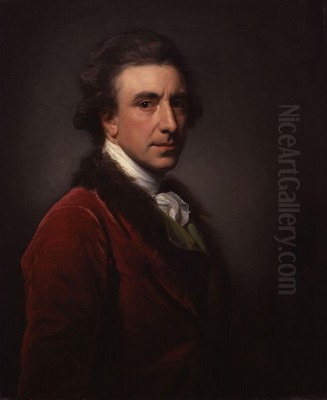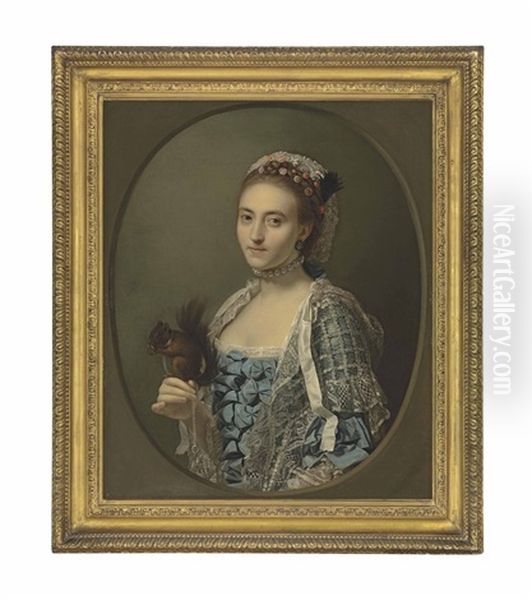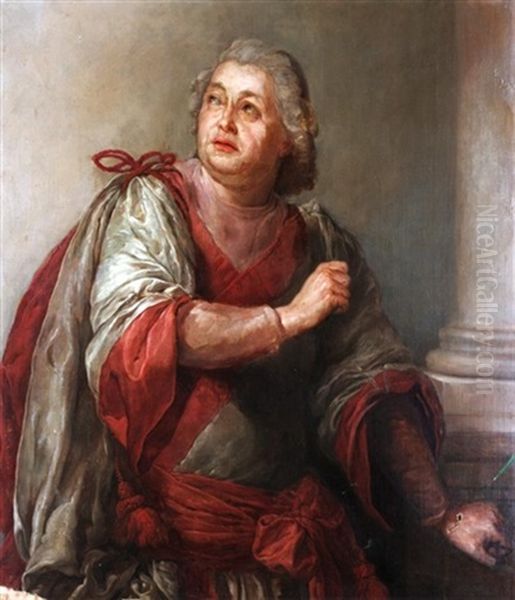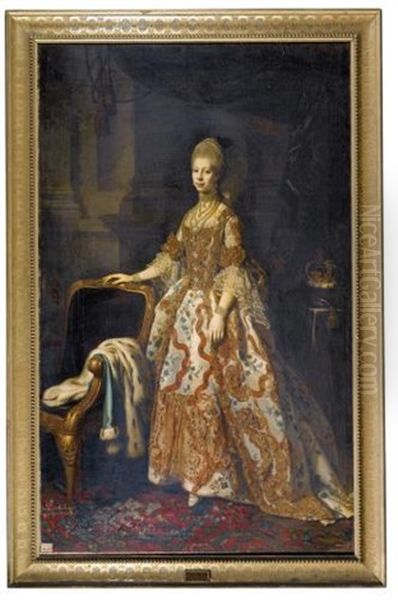
Sir Nathaniel Dance-Holland stands as a significant, albeit sometimes complex, figure in the landscape of eighteenth-century British art. Born into an era of burgeoning national confidence and cultural development, he navigated the worlds of Neoclassical painting and parliamentary politics, leaving a distinct mark on both. His career encompassed foundational work with the Royal Academy, influential portraiture, ambitious history paintings, and decades of service as a Member of Parliament. Understanding his trajectory reveals much about the opportunities and tensions inherent in the life of an artist and gentleman in Georgian England.
Early Life and Artistic Foundations
Nathaniel Dance was born in the bustling city of London on May 8, 1735. He was the third son of George Dance the Elder, a prominent architect who served as the Surveyor to the City of London. This familial connection to the arts and architecture undoubtedly provided a stimulating environment for the young Nathaniel. His initial artistic training was undertaken under the guidance of Francis Hayman, a respected painter and illustrator, and one of the founding members of the Royal Academy himself. Hayman's studio was a crucible for emerging talent, and his Rococo-influenced style, blended with a robust English realism, likely provided Dance with a solid grounding in technique and composition.
This early training in London set the stage for the next crucial phase of Dance's development: the Grand Tour. Like many aspiring artists and gentlemen of his time, he travelled to Italy to immerse himself in the art of antiquity and the Renaissance masters. This period abroad would prove transformative, shaping his artistic style and expanding his professional network.
The Italian Sojourn: Neoclassicism and Connections
Dance spent a considerable period, approximately a decade, living and working in Italy, primarily in Rome. This immersion was fundamental to his artistic evolution. He moved beyond the style of Hayman and absorbed the burgeoning Neoclassical aesthetic that was captivating the European art world. Rome, with its ancient ruins and collections of classical sculpture, was the epicentre of this movement.

During his time in Italy, Dance encountered Pompeo Batoni, one of the most sought-after portrait painters in Rome, particularly favoured by British Grand Tourists. While the exact nature of their relationship is debated – whether Dance was a formal pupil or simply moved within Batoni's circle and absorbed his influence – Batoni's elegant compositions, refined technique, and ability to imbue sitters with a sense of classical dignity clearly impacted Dance's own approach to portraiture and history painting.
Italy was also where Dance formed a significant, and reportedly complex, relationship with the Swiss-Austrian painter Angelica Kauffmann. Kauffmann was another key figure in the Neoclassical movement, celebrated for her history paintings and portraits. They moved in the same artistic circles, and sources suggest a deep connection, possibly a romantic one, though it appears not to have culminated in marriage. Later accounts, though sometimes speculative, even suggest tensions and perhaps professional rivalry or personal slights coloured their interactions after both returned to London.
His time in Italy was productive. He painted portraits of visiting Britons and began tackling ambitious history paintings based on classical themes, honing the style that would characterise his mature work. Works like The Meeting of Dido and Aeneas (1766), depicting a poignant scene from Virgil's Aeneid, showcase his engagement with classical literature and the Neoclassical emphasis on clear narrative, controlled emotion, and carefully rendered figures, influenced by his Italian experiences.
Return to London and Academic Prominence
Around 1765, Nathaniel Dance returned to London, his reputation enhanced by his Italian studies and connections. He quickly established himself as a successful portrait painter, securing commissions from the aristocracy and gentry. His style, which blended Italianate grace and Neoclassical seriousness with a solid British sense of character, found favour with patrons.
His standing within the London art world was cemented in 1768 when he became one of the founding members of the Royal Academy of Arts. This was a pivotal moment for British art, establishing a formal institution for training artists and exhibiting work. Dance joined luminaries such as Sir Joshua Reynolds (the first President), Thomas Gainsborough, his former teacher Francis Hayman, the American-born history painter Benjamin West, and his own brother, the architect George Dance the Younger.
Dance was an active participant in the Academy's early years, exhibiting regularly between 1769 and 1776. His submissions included both portraits and history paintings, contributing to the Academy's goal of elevating the status of British art. His involvement placed him at the very centre of the British art establishment, alongside the leading figures of the day.
Major Works and Artistic Style

Nathaniel Dance-Holland's oeuvre reflects his training and the artistic currents of his time. His style is generally characterised as Neoclassical, though it retains a distinctly British flavour, particularly in his portraiture. He demonstrated proficiency in both portrait and history painting, the latter being considered the highest genre according to Academic principles.
One of his most famous works is the Portrait of Captain James Cook (1775-1776), now housed in the National Maritime Museum, Greenwich. Commissioned after Cook's second voyage, the portrait depicts the celebrated navigator in his captain's uniform, holding a chart, presenting an image of quiet authority and intellectual capability. It has become the defining image of Cook, reproduced countless times. The painting showcases Dance's skill in capturing a likeness while also conveying the sitter's public persona and achievements.
His history paintings, such as The Meeting of Dido and Aeneas (1766), demonstrate his ambition to engage with grand classical themes. The composition is carefully structured, the figures rendered with anatomical precision, and the emotional tenor controlled, all hallmarks of the Neoclassical style he absorbed in Italy. Another notable history painting mentioned is The Death of Virginia, cited by some sources as a pioneering example of British history painting based on Roman history, competing in a field also explored by contemporaries like Gavin Hamilton and Benjamin West.
Dance also painted portraits of royalty and high society. His 1769 portrait of King George III and Queen Charlotte, along with other members of the royal family, further solidified his standing. However, his portraiture could sometimes be subject to criticism; a later depiction of Queen Charlotte (1773) was noted even by contemporaries for not being a particularly accurate likeness, perhaps indicating a tendency towards idealisation or a variable approach depending on the commission. The Portrait of Oliver Craster is another example cited, showcasing his ability to use light, shadow, and detailed rendering of costume to define character.

Compared to his great contemporaries, Dance's style differs subtly. He lacked the painterly bravura and psychological depth often found in Reynolds's portraits, nor did he possess the fluid elegance and sensitivity to landscape seen in Gainsborough's work. His approach was perhaps more solid, linear, and grounded, reflecting his architectural background and Neoclassical training. He faced competition not only from these giants but also from other successful portraitists like George Romney and Allan Ramsay, and in the realm of history painting, from figures like Henry Fuseli and Thomas Jones, who also explored classical and literary themes, often with more dramatic or romantic sensibilities. Other contemporaries like Joseph Wright of Derby focused on different themes, while Johann Zoffany excelled in conversation pieces.
The Transition to Politics and Later Life
A significant shift occurred in Dance's life around 1782 when he effectively ceased painting professionally. This change coincided with his marriage in 1783 to Harriet Thomas Dummer (née Bisshopp), the wealthy widow of Thomas Dummer and daughter of Sir Cecil Bisshopp, Bart. This marriage brought him considerable wealth and property, including estates in Hampshire and Sussex.
His newfound financial independence allowed him to pursue a different path: politics. In 1790, he formally resigned from the Royal Academy, signalling his departure from the professional art world. That same year, he was elected Member of Parliament for East Grinstead in Sussex, a seat he held for several terms. He later represented Great Bedwyn (1802-1806) before returning briefly to the East Grinstead seat (1807 until his death). His political career appears to have been relatively conventional for a country gentleman of the period.
In recognition of his standing, or perhaps his political service, he was created a Baronet on November 27, 1800. It was at this point that he added his wife's name, Holland, to his own, becoming Sir Nathaniel Dance-Holland, Bart. This transition from professional artist to landed gentleman and politician was not unique, but it marked a definitive end to his significant contributions as a painter.
Legacy and Art Historical Evaluation
Sir Nathaniel Dance-Holland died on October 15, 1811, in Winchester, Hampshire. His legacy is twofold: that of a talented and influential painter during a key period of British art, and that of a Member of Parliament. In art history, he is primarily remembered as a prominent portraitist and an early adopter of Neoclassicism in Britain.
His role as a founding member of the Royal Academy is significant, placing him among the architects of the institution that would dominate British art for generations. His portraits, particularly that of Captain Cook, remain important historical documents and accomplished works of art. His history paintings, while perhaps less numerous or consistently acclaimed than those of West or Kauffmann, represent a serious engagement with the highest genre of academic art.
However, his reputation has perhaps been somewhat overshadowed by the towering figures of Reynolds and Gainsborough. His decision to abandon painting for politics also meant his artistic career was effectively curtailed in mid-life, limiting his potential later output. Furthermore, the controversy surrounding his relationship with Angelica Kauffmann adds a layer of complexity to his biography, with some historical accounts suggesting professional jealousy or personal animosity played a role in their interactions.
The preservation state of some of his works, affected by the passage of time, can also impact modern assessment. Nevertheless, his paintings are held in major collections worldwide, including the National Portrait Gallery in London, the National Maritime Museum, Tate Britain, and the National Gallery of Victoria in Australia, ensuring his contribution is not forgotten.
Conclusion
Sir Nathaniel Dance-Holland occupies a unique position in British cultural history. He was an artist of considerable skill, trained in the Rococo manner but shaped by the Neoclassical ideals encountered during his formative years in Italy. As a founding member of the Royal Academy, he helped shape the institutional framework for British art. His portraits captured the likenesses of key figures of his age, while his history paintings demonstrated his academic ambitions. His later transformation into a landed gentleman, politician, and Baronet illustrates the fluid social boundaries and diverse life paths available to successful individuals in Georgian Britain. While perhaps not reaching the absolute pinnacle occupied by Reynolds or Gainsborough, Dance-Holland remains an important figure whose life and work offer valuable insights into the art, society, and politics of eighteenth-century Britain.